Having passed up the opportunity for various reasons to go the Amazon Rainforest in Brazil, Bolivia and Peru, in Ecuador we finally decided to venture into one of the defining
features of the South American Continent. The Amazon Basin comprises of 8,235,430 km2 in 8 South American countries, with Brazil having the largest coverage at 67% and Ecuador being one of the smallest at around 1.5%.
La Reserva de Producción Faunística Cuyabeno
The Amazon Rainforest is thought to be the oldest tropical forest area in the world, as much as 100 million years old and our journey was to take us into the primary rainforest
of the Cuyabeno Reserve. We boarded a 12 person motorised canoe to head down river, the hour long journey took 3 hours to complete as we were constantly on the look out for wildlife, none we would have seen on our own if it
were not for our guide Juan who had the eyes of a hawk, well in fact his nickname amongst his peers was Gato as his eyes looked like a cats.
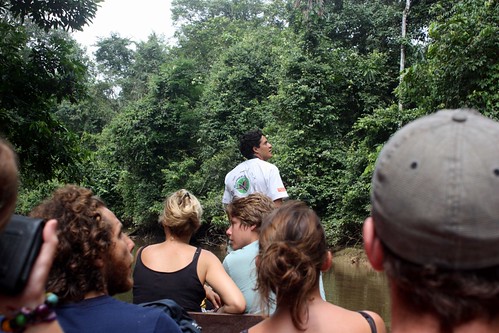
Unlike the Galapagos where the wildlife is both abundant and easily visible, photographing moving animals in trees from a moving or at least rocking boat is not easy, so for
some of the animals you’ll just have to take our word that we saw them as we have no photographic evidence. Our first sighting was of monkeys feeding high in the canopy, before we came across a snake sunning itself above the river as we passed by it in the boat.

Along the way we saw lots of beautiful butterflies and even saw a two-toed sloth slowly making its way along the upper branches of the trees. When we finally arrived at the
lodge we were showed to our accommodation which was basic, but then in the middle of the jungle with no electricity it was more than we could have expected for such a remote location.

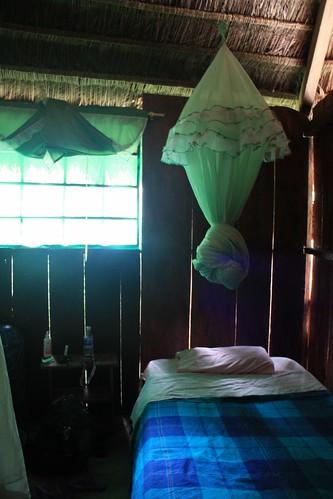
Our first real excursion was to the black waters of Laguna Grande where along the way we saw a couple of rare pink river dolphins that come to feed near the laguna at this
time of year.
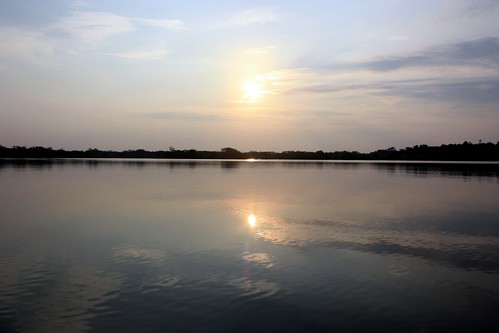
Then we set about searching for the biggest snake in the world, the Anaconda. While searching through the mangroves and hollow trees that the huge constrictors use as a home, Juan and Anaconda Hunter Jo, saw
the distinctive diamond pattern of an anacondas skin poking out under the water next to a tree. By the time we had turned the boat around, the snake had retreated further into it’s home, but that didn’t stop our guide
and driver trying to see if it wanted to come out to play!
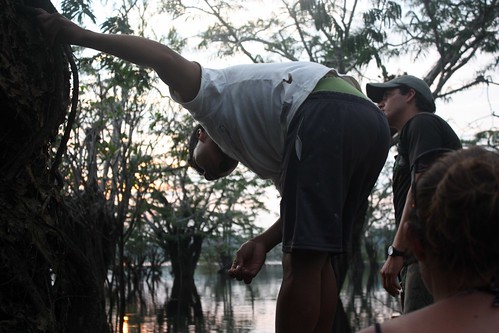
Unfortunately, or fortunately depending on your perspective, the anaconda stayed in it’s tree and we went to watch the sunset from the lagoon. What do you do after driving
30 metres away from an anaconda sighting during their prime feeding time? Why you go for a swim of course!
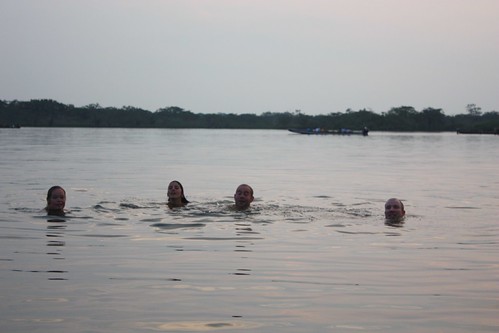
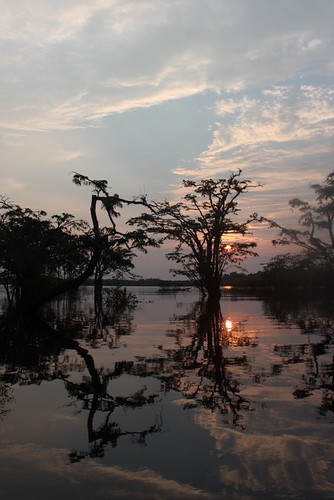
After the sunset, when most of the animals in the Amazon come out, we went for a night walk in the forest and it wasn’t long before we came across this fellow...

To make the walk more “exciting” for us (read as nerve wracking), Juan decided he didn’t wanted to follow the well trod path but would give us an “extreme” experience
by making us walk off the path through the thick foliage and trees with just our small headlamps to light the way, knowing that a whole heap of deadly creatures lurked all around us. We soon encountered Cappuccino and Scorpion
spiders, Leaf cutter ants and a snake to top it off. It was quite a rush not knowing what was out there and what we might discover, but thankfully we survived without incident.
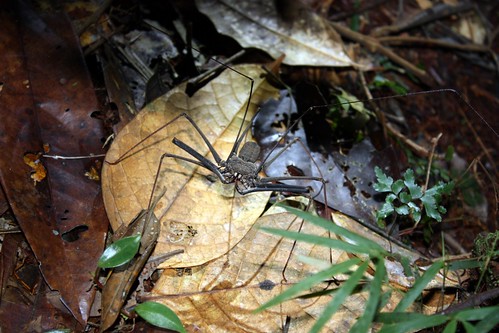

It was now time to head back for dinner and with no lights other than a torch that Juan was using to search for wildlife, our driver Miguel somehow managed to navigate his
way through the rivers, but not before Juan managed to spot a few giant Caiman by the rivers edge with his torch.
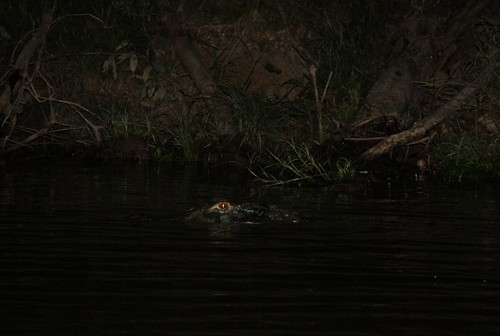
We arrived back at the lodge safely for dinner, amazed by how much we had managed to see in just one day in the wild. After thoroughly checking our room with our head torches
for any uninvited guests, we retired for the evening. Our next day started with another jungle walk but this time in the daylight where different kinds of equally dangerous animals come out to hunt, as well as finding a scorpion
having its breakfast, we encountered some poisonous but very colourful frogs.
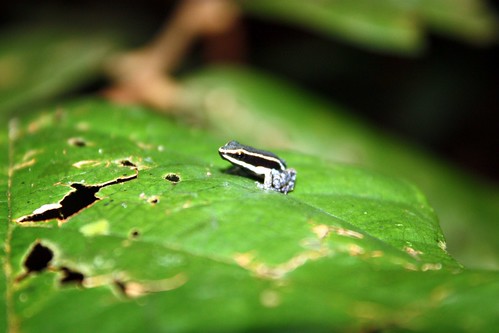
The trek also involved wading through a swamp which at some points came up to our knees, countless times we nearly fell flat on our faces or thought that we were going to
lose our rubber boots, so we used the trees to support ourselves, until we both got bitten on the hands by ants! But that was not quite as bad as when Juan told us to be careful of the snake that was prying around the swamplands,
but eventually we made it out safe and in one piece.
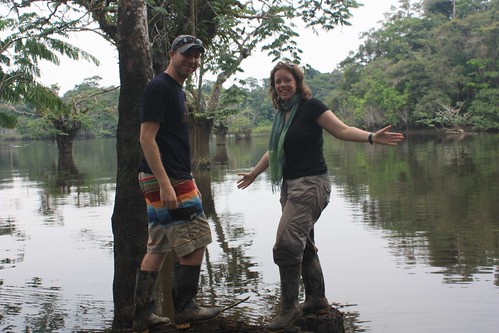
After lunch and chilling out at the lodge for a few hours we went out on the boat for our evenings activity, fishing. I’m sure nobody on the boat would have taken up the
offer if you had asked them if they wanted to spend the evening fishing, but with the word Piranha added before it we couldn’t get enough of it. The most spectacular catch of the day belonged to Jo, who with her first catch
managed to somehow land a piranha without the use of a hook, scaring the bejesus out of everyone as the piranha danced freely around the bottom of the boat. The fish kept getting bigger in size and while fishing over different
sides of the boat we managed to catch a couple at exactly the same time, before setting them free once more.
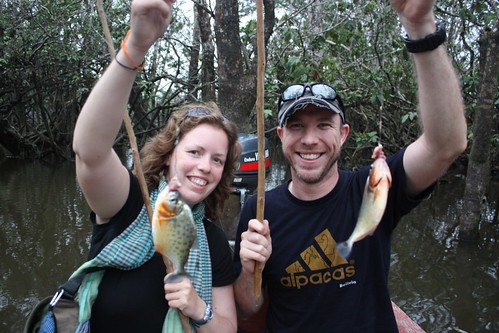
After the fishing was over there were strangely no takers for swimming that evening! So we spent longer searching for caimans, again driving around in the pitch darkness we
still weren’t sure how Miguel managed to see where he was driving. While we were out at night it certainly hit home that if anything was to happen on the river, the boat wouldn’t stand much chance of survival and we were
always relieved to return to the safety of the lodge, where we only had to worry about these things crawling about our heads at dinner.
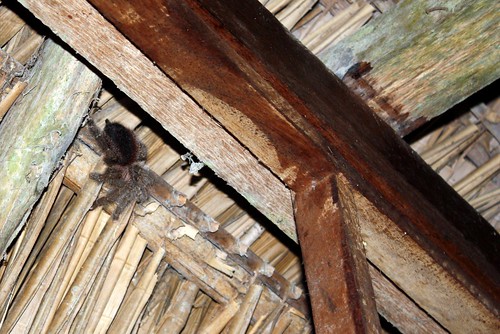
The next day our first port of call was the Samona tree for which our lodge was named and the largest tree in the Amazon.
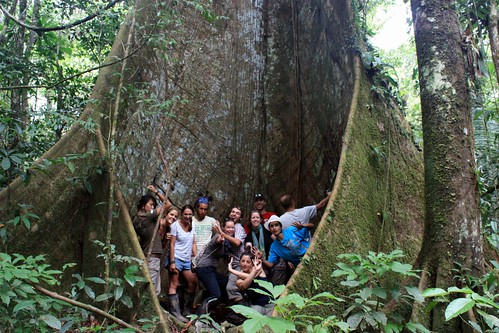
We then called in at local indigenous village. Well as indigenous as a village can be when they have tour groups visiting all of the time. Despite my usual cynicism for these
types of excursions this one was worth while. The village lies in a national park but the villagers own the land and a great deal of oil has been found in the area, which means that large oil companies have offered the villagers
a lot of money to sell it to them, which would inevitably lead to the destruction of the ecosystem in this beautiful area. Although making a lot less than they could through selling the land, by accepting tours they can lead
a more sustainable living for themselves and future generations while helping preserve the flora and fauna. The lodges also hire the locals as guides and drivers to ensure the work is kept within the community.
At the village we helped to prepare a traditional desert made from the Yucca plant, well the meal was for us after all and in reality we did very little leaving the majority
of the work to our cook Gabriella, who knew how to use a machete.
While we were supposed to be helping the majority of us were playing with Nacho the monkey who had paid us a visit, although of course Nacho knew that food was being prepared
and was looking for a free feed.
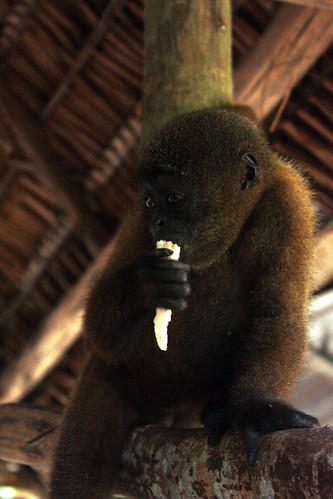
In the evening we went searching for anacondas again, as well as one last swim in the laguna, before cruising for caimans once more. We also managed to be scared half to death
when Juan decided that it would be a good idea to bring a snake onto the boat, so that we could take pictures of it, at which point a fellow traveller so frightened bit her boyfriend who was shielding her from the Boa.
After returning to the lodge we went on a more sedate walk in the area around our accommodation looking for different species of frog that would serenade us to sleep each night,
including the tree frog
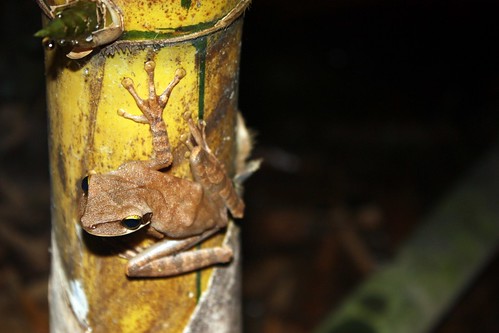
On our last morning we got up at 5.30 to catch the earlier risers and were treated to toucans, stinky turkeys, cormorants, a sloth and some monkeys, as well as a morning caiman
who was waiting to see if the monkeys would come too low into the branches when they were feeding.

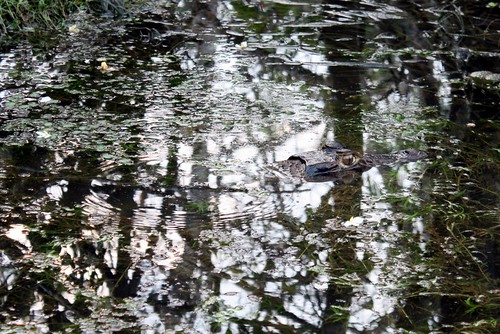
After breakfast it was then time for us to catch a boat upriver to leave the reserve. We were surprised by the amount of wildlife that we were able to see. We saw pretty much
everything that we could have hoped to see but the most surprising thing, along with the fact that it wasn’t as hot and humid as we had expected, was that, despite the location, we didn’t get a single mosquito bite between
us!
Tena
Is a large jungle town about five hours south of Cuyabeno and it was here that the heat and the mosquitoes finally caught up with us and we were
also struck down with a severe case of beer ‘o’ clock
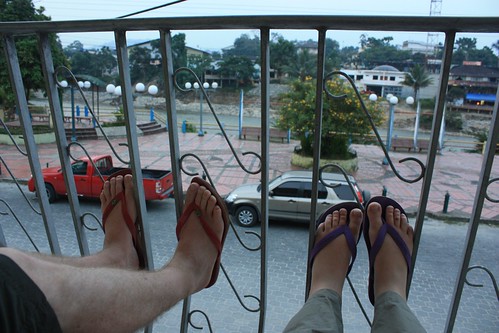
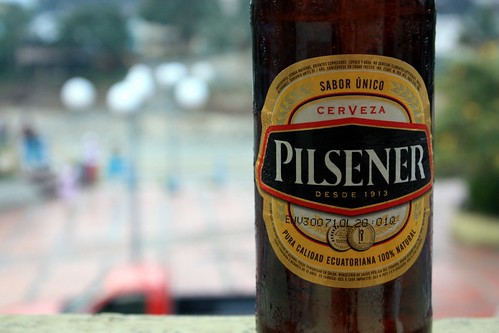
After a few days of relaxing and catching up on the events of the world we decided to travel to...
Puyo
We never actually made it to Puyo. Buses in Ecuador tend not to stop at the main terminal but just anywhere in town or at the bus company’s office. Normally the bus conductor
will tell us when it is time to disembark, but not this day, so we just sat there unaware of where we were heading. A new passenger asked for a ticket to Baños, which was due to be the next town we visited anyway, so we just
stayed on the bus, kept quiet and got a free ride all the way there, but more on that next time.
Ryan y Jo
Photos: http://www.flickr.com/photos/dojo77/